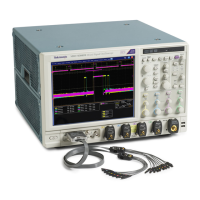Specifications (MSO70000/C Series, DSA/DPO70000B/C Series, and DPO7000 Series)
Table 1-6: Input/output port specifications, all MSO70000/C, DSA/DPO70000B/C, and DPO7000 Series models (cont.)
Characteristic Description
High speed serial data and clock
output voltages, typical,
≥ 4 GHz models
Voh = -1.0 V
Vol = -1.7 V
Assumes a load impedance greater than 1 kΩ.(50Ω source termination.)
If a 50 Ω or 75 Ω load is used, either use a DC blocking capacitor in series with the signal or
reference the termination to about -1.3 V. The signal amplitude will be correspondingly reduced.
High speed serial data output
latency, typical,
≥ 4 GHz models
11 ns ± 4 ns, plus 35.5 clock cycles
Probe Compensation output
step amplitude and offset
≥ 4 GHz models 440 mV ± 22% into a 50 Ω load (Vol = -0.2 V to 0 V, Voh = 0.2 V to 0.4 V, typical)
810 mV ± 2
2%intoa10kΩ load, (Vol = -0.4 V to 0 V, Voh = 0.4 V to 0.8 V)
<4GHzmo
dels
1 V ± 1.5%
into a ≥ 100 kΩ load (Vol = -1.0 V, Voh = 0 V typical)
Add 0.05% /°C for temperatures greater than or less than 25 °C
Probe Compensation output step
frequency
≥ 4 GHz models 1 kHz ± 20%
< 4 GHz models 1 kHz ± 5%
Probe Calibration output step rise
time
,typical
≥ 4G
Hz models
300
ps (10% to 90%) directly into an input channel. To deskew a probe, use a 50 Ω terminator
in series with the deskew fixture to minimize HF aberrations.
< 4 GHz models ≤350 ps at 1 V, into a ≥20 K Ω load to ground.
≤1nsat2V,intoa50Ω load to ground.
To
deskew a probe, use a 50 Ω terminator in series with the deskew fixture to minimize HF
aberrations.
Probe Calibration output step
aberrations, typical
≤ ± 1% after the first 500 ns following the square wave transition. To deskew a probe, use a
50 Ω terminator in series with the deskew fixture to minimize H F aberrations.
Jitter of internal Probe Calibration
t
rigger, typical
5psRMS
MSO70000/C, DSA70000B/C, DPO7000B/C, DPO7000, MSO5000, DPO5000 Series 1–53
